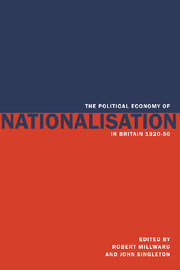Book contents
- Frontmatter
- Contents
- List of tables
- List of contributors
- Preface
- I Government and industry 1920–50
- II Case studies of industry organisation, performance and nationalisation
- 3 The coal industry: images and realities on the road to nationalisation
- 4 The changing role of government in British civil air transport 1919–49
- 5 The motor vehicle industry
- 6 The railway companies and the nationalisation issue 1920–50
- 7 The motives for gas nationalisation: practicality or ideology?
- 8 Public ownership and the British arms industry 1920–50
- 9 The water industry 1900–51: a failure of public policy?
- 10 Debating the nationalisation of the cotton industry, 1918–50
- III Government and the process of industrial change in the 1940s
- IV Review and Conclusions
- Index
3 - The coal industry: images and realities on the road to nationalisation
Published online by Cambridge University Press: 07 May 2010
- Frontmatter
- Contents
- List of tables
- List of contributors
- Preface
- I Government and industry 1920–50
- II Case studies of industry organisation, performance and nationalisation
- 3 The coal industry: images and realities on the road to nationalisation
- 4 The changing role of government in British civil air transport 1919–49
- 5 The motor vehicle industry
- 6 The railway companies and the nationalisation issue 1920–50
- 7 The motives for gas nationalisation: practicality or ideology?
- 8 Public ownership and the British arms industry 1920–50
- 9 The water industry 1900–51: a failure of public policy?
- 10 Debating the nationalisation of the cotton industry, 1918–50
- III Government and the process of industrial change in the 1940s
- IV Review and Conclusions
- Index
Summary
Introduction
On 1 January 1947 the assets of British coalmining were vested with the National Coal Board. The Board took control of an industry with over 1,200 pits and 0.7 million workers. Capital assets, including mineral rights, valued at £390 million thus came under the control of a single organisation (Ashworth 1986, p. 28). That there was little opposition to the transfer of these assets to a public corporation shows the minimal public esteem private ownership of the mines enjoyed by 1946 (Supple 1986, p. 228). Yet less than a decade before the onset of the Second World War, a scheme by the Coal Mines Reorganisation Commission to concentrate production in six large undertakings, one in each of the major British coalfields, was ridiculed as economic nonsense, and throughout the 1930s more modest attempts at reorganisation foundered in the absence of wholehearted government support (Kirby 1977, p. 155). What was different by the time the Coal Industry Nationalisation Act received Royal Assent in 1946 was that the Second World War had both laid bare the frailties of British coalmining and transformed the labour market. By the end of the war the technology and organisation of the industry were adjudged inadequate, and private ownership deemed to have failed. Even The Times' (1945, p. 46) eulogy to British war production had to admit that coal was a problem. Equally important, both the miners' and the Labour Party's enthusiasm for nationalisation prior to the war had been tempered by an awareness that reorganisation might reduce employment (Political and Economic Planning 1936, p. 96). The acute difficulties in recruiting miners provided by 1945 a very different backcloth to the nationalisation debate.
- Type
- Chapter
- Information
- Publisher: Cambridge University PressPrint publication year: 1995
- 5
- Cited by



